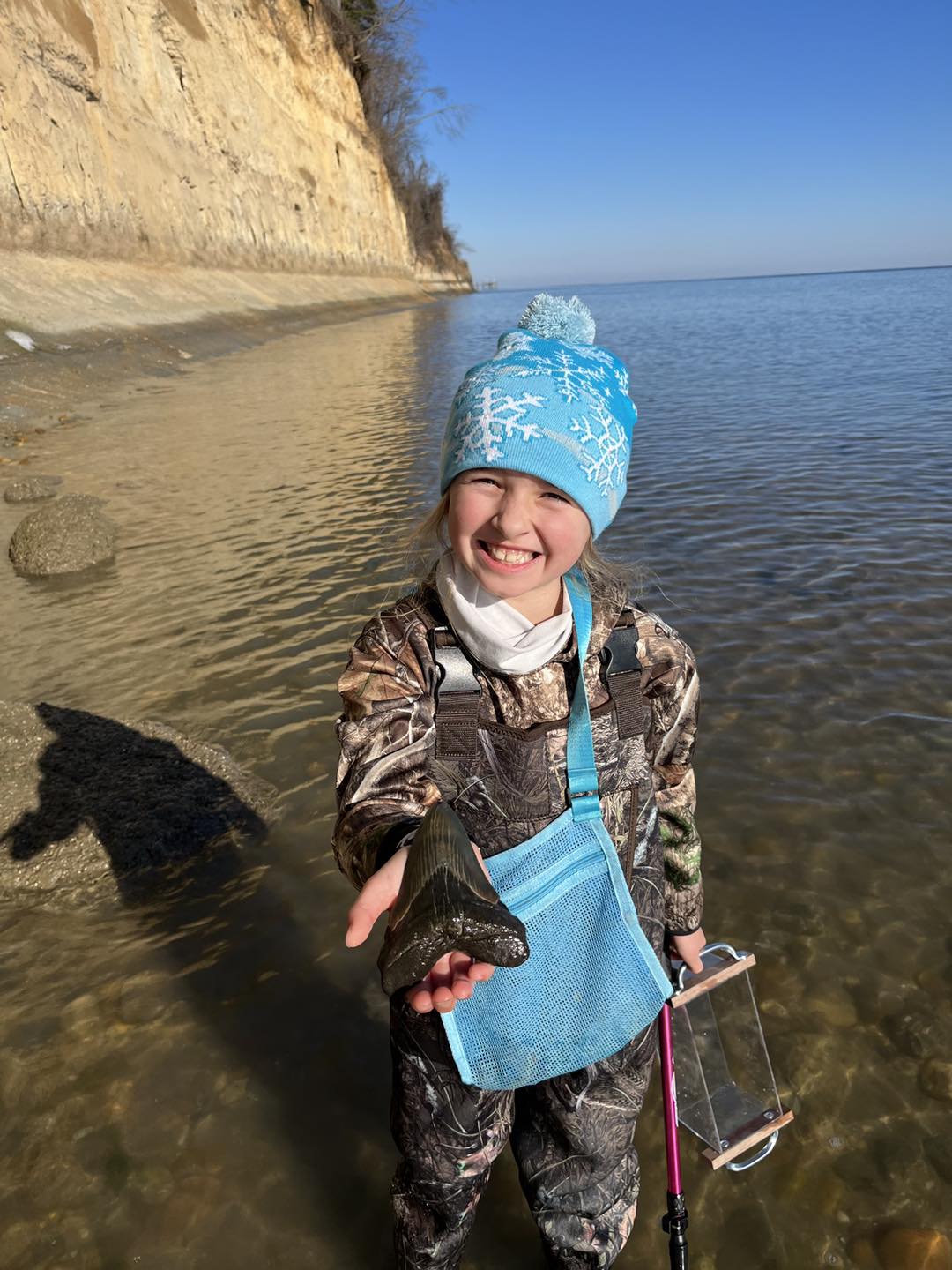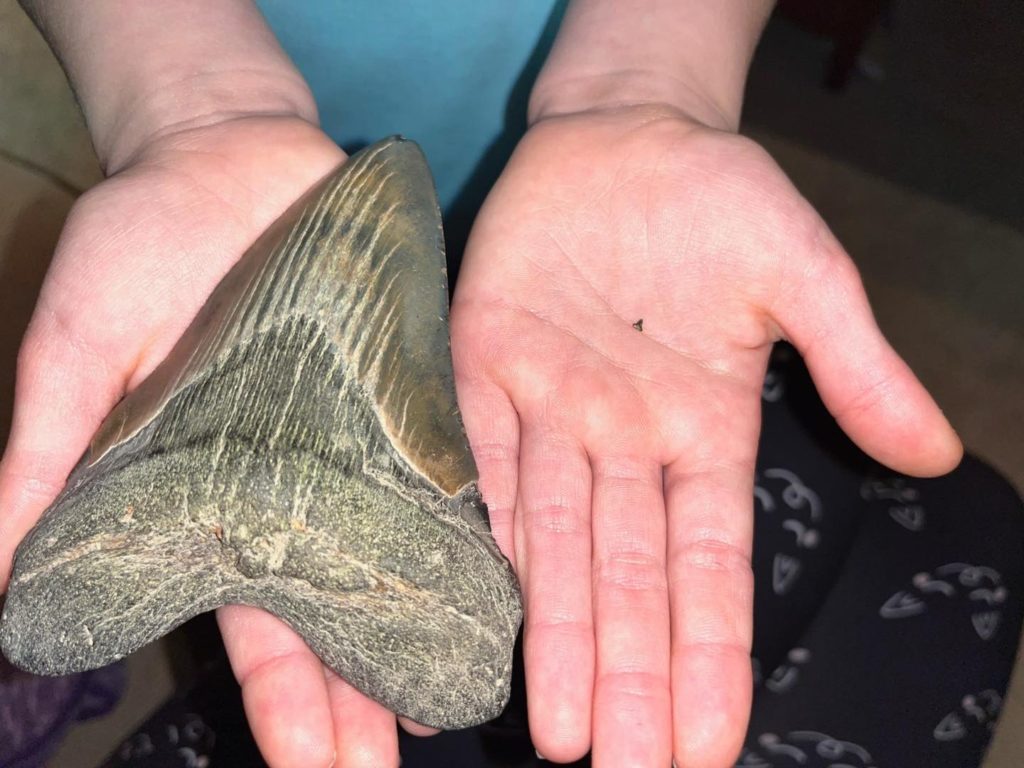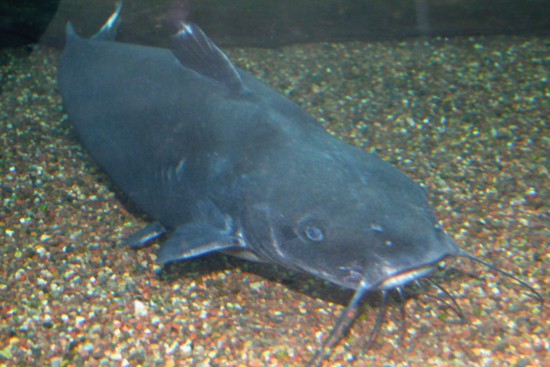A Calvert County, Md., elementary schooler made national headlines this month for her eye-popping fossil discovery at Calvert Cliffs. And now she wants to show others that fossil hunting is a great chance to spend time on the Bay.
You may remember last week we showed you the massive, sediment-encased fossilized whale skull a Pennsylvania man found on the beach at Calvert Cliffs, which was then precariously moved to Calvert Marine Museum.
This week, we meet Molly Sampson, a budding paleontologist from Prince Frederick, Md.
It was Christmas morning when Molly, 9, and her family went out searching for fossil “treasure” along the shore. Dad Bruce Sampson is a lifelong fossil hunter himself and he outfitted the kids with new equipment for Christmas, including cold water gear and a handmade “viewfinder” made of plexiglass and wooden handles.

Photo courtesy of Sampson family.
Wearing the brand new camouflage waders she got, Molly went with her dad and siblings out in single-digit temperatures at dead low tide.
Her mom, Alicia, stayed back. She said it was only about 25 minutes after the family left that Bruce texted: Molly made an amazing discovery.
Wading in knee-deep water, she spotted a huge megalodon tooth—larger than her hand. Molly shared her discovery with the marine museum’s paleontology department, who shared it with social media.
Quickly, Molly was getting national attention. With the help of her mom and sister, she created an Instagram page to share her finds. Living close to several fossil-rich areas, the Sampson family hunts for treasure nearly every day. Molly, who started toddling around looking for shark teeth at age one, has over 400 teeth and other fossils in her personal collection.
Why is Calvert Cliffs such a hotbed for prehistoric shark teeth and other ancient relics? Fossils are easy to find there because wind and water are constantly eroding the cliffs, which contain generation after generation of Miocene sea life, sealed off by sand and silt that helped preserve their skeletons (or teeth). The deposits of the Calvert Cliffs that were once sea bottom now stand 100 feet above the water line, according to the Maryland Geological Survey (MGS).
MGS says it’s believed the area was a calving ground for whales. Bones of young and immature whales have been recovered with scratches and scars from sharks, suggesting that sharks were drawn to feed on the easy prey of young whales. Calvert Cliffs represents the most extensive assemblage of fossils from the Miocene Epoch anywhere in the Eastern United States—those of sharks and of the animals they fed on, from whales and turtles and clams and sand dollars.
The most common teeth found in the area from extinct sharks include those of tiger, hammerhead, requiem, mackerel, and sand sharks. Megalodon teeth are more rare. And Calvert Marine Museum Curator of Palentology Dr. Stephen Godfrey told the Sampsons that a fully-intact megalodon tooth as large as the one Molly found is especially rare.
Her dad Bruce has never found such a specimen in his 35-plus years of fossil hunting.
“I can’t help but be a little bit jealous,” he said, in good humor.
If these recent exciting discoveries make you want to put on some waders and find something new, follow Molly and her family’s advice: “If you’re looking for shark’s teeth, go at low tide. Be somewhere near where the cliffs are. You have to train your eye to see them—look for the right shape, the right color.”
Molly tells other children she sees out hunting to look on the surface of the sand where the water comes up. The day we spoke to the Sampsons, they were at Flag Ponds Nature Park in Lusby, and mom Alicia says Molly helped a young boy find his first shark teeth.
If you find a fossil or tooth and want to learn more about it, bring it in to Calvert Marine Museum for their new First Fossil Friday program. On the first Friday of each month, members of the public can show their discoveries to museum staff to be identified. The next one is February 3, 2023, 1-4:30 p.m. (Fossil identification is free, but admission fees apply for access to the marine museum’s exhibits.)
-Meg Walburn Viviano




